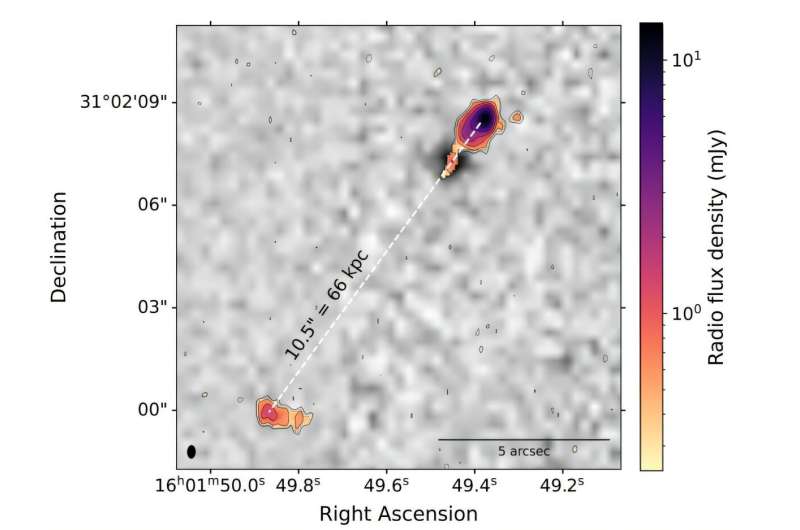
Large radio jet discovered in quasar J1601+3102 (Image Credit: Phys.org)

An international team of astronomers has observed an extremely radio-loud quasar known as J1601+3102. As a result, they found that the quasar hosts a large extended radio jet. The discovery is reported in a research paper published Nov. 25 on the arXiv preprint server.
Quasars, or quasi-stellar objects (QSOs), are active galactic nuclei (AGN) of very high luminosity powered by supermassive black holes (SMBHs), emitting electromagnetic radiation observable in radio, infrared, visible, ultraviolet and X-ray wavelengths. They are among the brightest and most distant objects in the known universe, and serve as fundamental tools for numerous studies in astrophysics as well as cosmology.
J1601+3102 is an extremely radio-loud quasar at a redshift of 4.9, discovered in 2022. It has a radio flux at a level of 69 mJy, bolometric luminosity of about 26 quattuordecillion erg/s and a steep spectral index.
Recently, a group of astronomers led by Anniek Joan Gloudemans of the Gemini Observatory decided to take a closer look at J1601+3102, hoping to shed more light on its properties. For this purpose, they employed the Low Frequency Array (LOFAR)— a large and sensitive radio telescope operating at low radio frequencies. The observations were complemented by data from the Gemini Near-Infrared Spectrograph (GNIRS).
“We constructed a LOFAR VLBI [very long baseline interferometry] image at 144 MHz and observed the quasar with Gemini/GNIRS to obtain its (near-)infrared spectrum,” the researchers wrote in the paper.
LOFAR images revealed that J1601+3102 has an extended radio structure including a northern radio lobe, a southern radio lobe, and a core. The northern lobe is located about 29,000 light years from the optical quasar and has a total flux density of 50.6 mJy, while the southern one is at a distance of 185,800 light years, with a total flux density of 10.5 mJy.
Therefore, these findings indicate that J1601+3102 has a radio jet with an enormous size of at least 215,000 light years. The astronomers noted that this is only a lower limit, since the physical size of the jet is likely larger due to projection effects brought about by the viewing angle. They added that the jet of J1601+3102 is therefore the most extended radio jet ever observed at a redshift higher than 4.0.
The study also found that the mass of the SMBH in J1601+3102 is approximately 450 million solar masses. This value is generally lower when compared to SMBHs in the known high-redshift quasars. Hence, the authors of the paper concluded that an exceptional black hole mass is not strictly necessary to generate powerful jets in quasars.
More information:
Anniek J. Gloudemans et al, Monster radio jet (>66 kpc) observed in quasar at z~5, arXiv (2024). DOI: 10.48550/arxiv.2411.16838
Journal information:
arXiv
© 2024 Science X Network
Large radio jet discovered in quasar J1601+3102 (2024, December 4)
retrieved 4 December 2024
from https://phys.org/news/2024-12-large-radio-jet-quasar-j16013102.html
part may be reproduced without the written permission. The content is provided for information purposes only.





